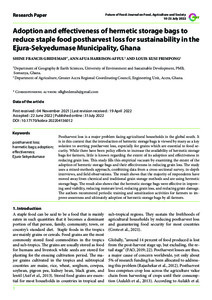| dc.date.accessioned | 2022-08-12T12:36:11Z | |
| dc.date.available | 2022-08-12T12:36:11Z | |
| dc.date.issued | 2022-07-31 | |
| dc.identifier | doi:10.17170/kobra-202204136012 | |
| dc.identifier.uri | http://hdl.handle.net/123456789/14053 | |
| dc.language.iso | eng | |
| dc.rights | Namensnennung 4.0 International | * |
| dc.rights.uri | http://creativecommons.org/licenses/by/4.0/ | * |
| dc.subject | postharvest loss | eng |
| dc.subject | hermetic bags | eng |
| dc.subject | adoption | eng |
| dc.subject | effectiveness | eng |
| dc.subject | Ejura-Sekyedumase | eng |
| dc.subject.ddc | 300 | |
| dc.subject.ddc | 630 | |
| dc.title | Adoption and effectiveness of hermetic storage bags to reduce staple food postharvest loss for sustainability in the Ejura-Sekyedumase Municipality, Ghana | eng |
| dc.type | Aufsatz | |
| dcterms.abstract | Postharvest loss is a major problem facing agricultural households in the global south. It is in this context that the introduction of hermetic storage bags is viewed by many as a key solution to averting postharvest loss, especially for grains which are essential to food security. While there have been policy efforts to increase the availability of hermetic storage bags for farmers, little is known regarding the extent of its adoption and effectiveness in reducing grain loss. This study fills this empirical vacuum by examining the extent of the adoption of hermetic storage bags and their effectiveness in reducing grain loss. The study uses a mixed-methods approach, combining data from a cross-sectional survey, in-depth interviews, and field observations. The result shows that the majority of respondents have moved away from chemical and traditional grain storage methods and are using hermetic storage bags. The result also shows that the hermetic storage bags were effective in improving seed viability, reducing moisture level, reducing grain loss, and reducing grain damage. The authors recommend periodic training and sensitization activities for farmers to improve awareness and ultimately adoption of hermetic storage bags by all farmers. | eng |
| dcterms.accessRights | open access | |
| dcterms.creator | Gbedemah, Shine Francis | |
| dcterms.creator | Harrison-Afful, Ann Afua | |
| dcterms.creator | Frimpong, Louis Kusi | |
| dc.subject.swd | Ghana | ger |
| dc.subject.swd | Westafrika | ger |
| dc.subject.swd | Region Ashanti | ger |
| dc.subject.swd | Nachhaltigkeit | ger |
| dc.subject.swd | Ernteverlust | ger |
| dc.subject.swd | Getreideernte | ger |
| dc.subject.swd | Getreidelagerung | ger |
| dc.subject.swd | Vakuumverpackung | ger |
| dc.subject.swd | Grundnahrungsmittel | ger |
| dc.subject.swd | Landwirtschaft | ger |
| dc.subject.swd | Effektivität | ger |
| dc.subject.swd | Markthandel | ger |
| dc.subject.swd | Konventionelle Landwirtschaft | ger |
| dc.subject.swd | Augenbohne | ger |
| dc.subject.swd | Maisanbau | ger |
| dc.type.version | publishedVersion | |
| dcterms.source.identifier | eissn:2197-411X | |
| dcterms.source.issue | No. 3 | |
| dcterms.source.journal | Future of Food: Journal on Food, Agriculture & Society | eng |
| dcterms.source.volume | Vol. 10 | |
| kup.iskup | false | |
| dcterms.source.articlenumber | 554 | |


